Quick Summary: Building a generative AI solution requires clear goals, strong backend systems, user-friendly frontend design, and reliable integrations. This blog explains what generative AI can do, types of models, development steps, and how businesses can adopt AI apps without creating full in-house teams. Learn how to streamline processes, improve decision-making, and deliver measurable business results with enterprise-ready AI development.
When smartphones first appeared, many businesses ignored smartphones. Executives relied on traditional processes and assumed digital tools would not change markets. Over time, companies that resisted adoption lost relevance, while early adopters gained dominance. The same cycle now applies to every generative AI solution in development.

The generative AI market itself shows the urgency. Market value stood at USD 13.5 billion in 2023. Analysts project the figure will reach USD 255.8 billion by 2033, growing at a CAGR of 34.2%. (Source)
This rapid growth signals how generative AI is becoming part of everyday business operations. Companies that invest early are already securing stronger competitive positions.
This leaves decision-makers with a pressing question: how to build a generative AI solution that truly fits their business? The answer requires clarity, planning, and the right approach. The following sections will break down each step in simple, actionable terms.
What can generative AI do?
A generative AI solution can create content, analyze data, and simulate ideas across industries. The technology helps businesses improve efficiency, personalize customer experiences, and unlock innovation by automating tasks that previously demanded significant human time and effort.
Generative AI is more than producing text or images. Businesses that build a generative AI solution can design new product concepts, forecast demand patterns, or create personalized recommendations. Each of these capabilities shortens delivery cycles, reduces budget leakage, and frees teams for strategic initiatives.
Generative AI solutions for business also enhance decision-making. AI models analyze complex data, highlight patterns, and suggest outcomes that guide leaders toward practical strategies. As part of evolving AI trends, this approach gives organizations a clear advantage in markets where delays often create losses.
When applied with well-defined goals, businesses that develop generative AI solutions treat them as reliable assistants. The technology supports leaders by strengthening operations, improving adaptability, and keeping customers engaged.
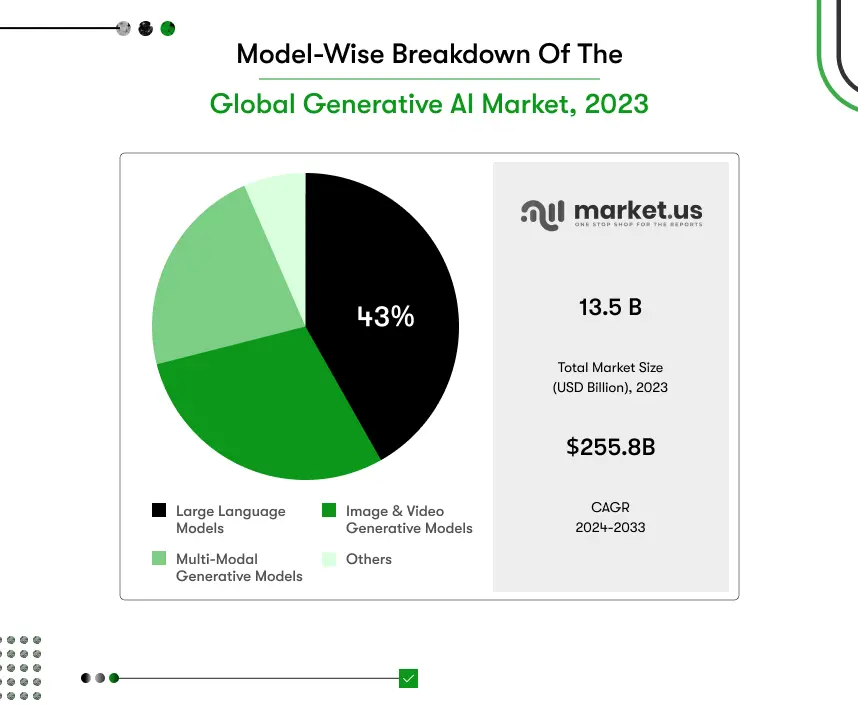
What makes a generative AI solution essential for businesses today?
Every leader knows the pressure of running a business today. Budgets stretch, deadlines slip, and customers expect more than ever. Traditional methods can only carry so much weight before teams feel overwhelmed. That’s where a generative AI solution starts to change the picture.
As you saw in the numbers earlier, adoption is climbing faster than anyone expected. Those figures only confirm what leaders already sense every day. Markets are moving quickly, and every delay gives competitors more space to get ahead.
Generative AI solutions for business step in as real problem-solvers:
- Workloads feel lighter when repetitive tasks are automated, leaving space for creative work.
- Decisions feel sharper because insights arrive quickly from data that once felt unmanageable.
- Customers feel valued when experiences match their needs at the right time.
- Innovation feels possible when leaders choose to build a generative AI solution with a clear purpose.
Imagine a retail chain facing constant inventory imbalance across different stores. Shelves run empty on busy days, while less popular items stay piled up. Managers debate stock decisions every week, and customers lose patience when essentials are unavailable.
With AI forecasting in place, inventory starts to match demand more closely. Stores carry what customers want, waste reduces, and managers finally make confident decisions guided by reliable insights.
Generative AI solutions for business have moved from experiments to core systems. These solutions give leaders confidence in operations, stability during growth, and new room to innovate, while expanding practical AI use cases across multiple industries.
What types of generative AI models exist for development?
A generative AI solution can rely on different model types, and each model serves specific business and technical purposes. Understanding these helps leaders choose the right development path, avoid wasted investments, and build solutions aligned with business outcomes.
1. Large Language Models (LLMs)
LLMs are trained on massive amounts of text data to understand and generate human-like language. These models can answer questions, summarize long documents, and even write original content. From a development perspective, LLMs are the backbone of many business applications.
- Used for building chatbots and virtual assistants.
- Automates customer support, content creation, and knowledge management.
- Helps summarize research, reports, or contracts for decision-making.
2. Generative Adversarial Networks (GANs)
Generative Adversarial Networks use two neural networks working in competition. One network creates new data while the other evaluates authenticity. Over repeated cycles, the generator improves until it produces highly realistic outputs that can support various industries.
- Generate synthetic images for product design and marketing.
- Produce videos and animations for media or advertising.
- Create synthetic datasets where real data is limited.
3. Diffusion Models
Diffusion models create content through a process of noise addition and removal. They begin with random patterns and refine outputs step by step. Developers prefer diffusion models for visual applications because the method preserves fine details and consistency.
- Produce images for creative campaigns or eCommerce catalogs.
- Support product design through scalable content generation.
- Power applications like Stable Diffusion and DALL·E.
4. Variational Autoencoders (VAEs)
Variational Autoencoders work by compressing data into smaller representations and reconstructing it. This approach allows them to identify anomalies and generate structured data. They may not create flashy visuals, but they are reliable for core business needs.
- Detects anomalies in transactions or manufacturing operations.
- Generate structured recommendations for online platforms.
- Provide stable outputs for analytics and predictions.
5. Transformer-Based Models
Transformers are the foundation of most advanced generative AI solutions. They process data in parallel instead of sequentially, which makes them highly efficient and scalable. Developers use transformers for complex tasks that combine multiple types of data.
- Power translation, summarization, and intelligent search engines.
- Enable multimodal solutions that connect text, vision, and audio.
- Form the architecture behind LLMs and modern generative systems.
Each type of generative AI model offers unique strengths for development. Large Language Models drive text-based systems, GANs and Diffusion Models create visual outputs, while VAEs and Transformers provide structured and scalable solutions. Together, these models form the foundation of business-ready AI applications and inspire innovative AI business ideas for enterprises.
The key is simple: selecting the right model ensures your generative AI solution delivers measurable value and supports long-term growth.
How to build generative AI solutions from scratch?
A generative AI solution requires a structured development process. Without following a proven path, businesses risk delays, wasted budgets, and poor results. These are the standard steps every organization must follow to build a generative AI solution successfully:
1. Define business goals clearly
Your generative AI solution starts with crisp, measurable objectives. Tie every objective to a business KPI and owner. Write success criteria before any design begins. Align stakeholders on scope, budget, risk, and expected timelines.
2. Audit and prepare data
Map every data source, ownership, sensitivity, and refresh cadence. Fix quality issues through cleaning, labeling, and de-duplication routines. Establish governance for consent, retention, and access controls. Strong data governance and quality pipelines support generative AI solutions for business at scale.
3. Select the right model type
Match tasks to LLMs, GANs, VAEs, or Diffusion models. Evaluate accuracy, latency, cost, context length, and fine-tuning needs. Prefer proven checkpoints before considering custom training. This choice influences how you develop generative AI solutions responsibly.
4. Design a scalable architecture
Plan data pipelines, a feature store, and a vector database. Reliable pipelines come from strong orchestration, proper caching, and continuous monitoring. Without these, generative AI solutions slow down and fail to scale effectively.
5. Develop and test prototypes
Ship a thin vertical slice with one real workflow. Define baseline metrics, human review steps, and rejection handling. Run red-team tests for safety and bias. This is how to build a generative AI solution that survives production.
6. Deploy and monitor systems
Use CI/CD, a model registry, and staged rollouts. Track quality, cost, drift, and user satisfaction on dashboards. Capture feedback loops for periodic retraining and prompt updates. Continuous monitoring keeps the generative AI solution stable and valuable.
Backend process for a Generative AI solution
The backend of a generative AI solution handles data, models, and infrastructure. It ensures that data pipelines are reliable, models are trained effectively, and security is built in. A strong backend keeps applications scalable, accurate, and compliant.
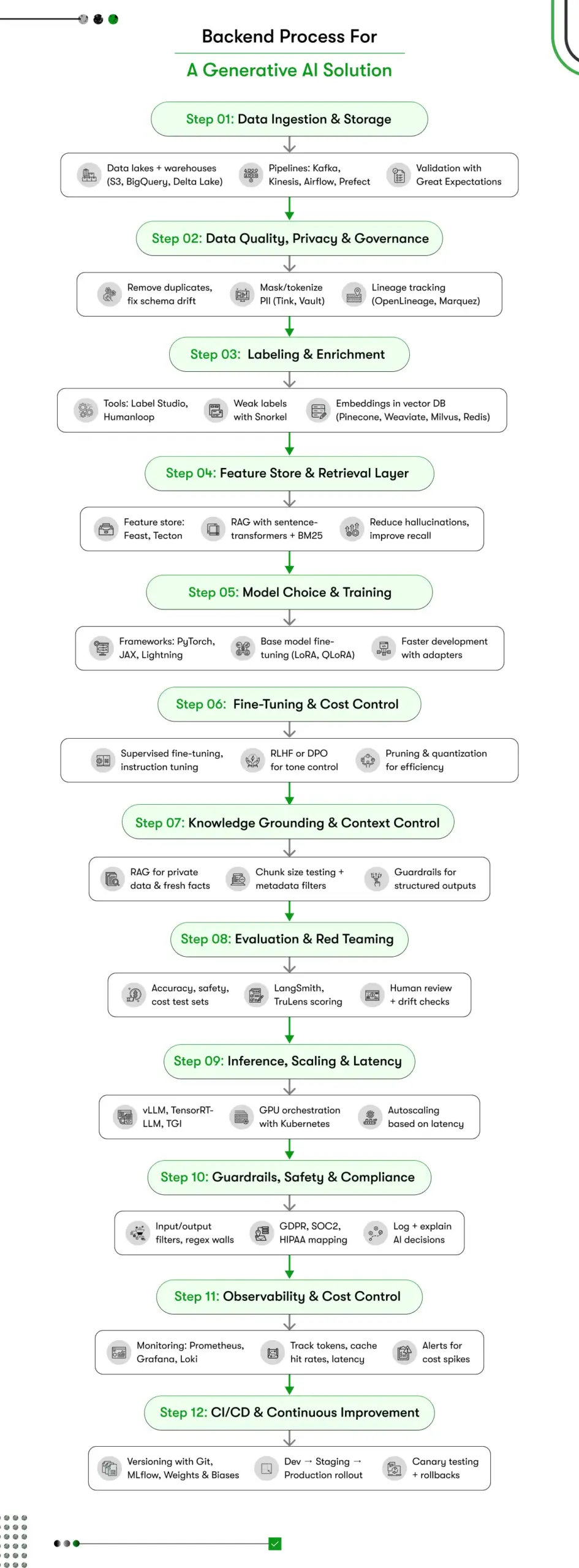
1) Data ingestion and storage
Use a reliable data lake and warehouse together. Common choices include S3 with LakeFS, Delta Lake, or BigQuery. Ingest data with Kafka or Kinesis for streams. Use Airflow, Dagster, or Prefect for scheduled pipelines.
Validate files with Great Expectations to catch bad records early. Store raw, cleaned, and curated layers separately. This structure keeps lineage and rollbacks simple for every Generative AI solution.
2) Data quality, privacy, and governance
Remove duplicates, fix schema drift, and standardize formats. Mask or tokenize PII with tools like Tink or Hashicorp Vault. Control access with IAM, fine-grained policies, and short-lived credentials.
Track lineage with OpenLineage or Marquez. Keep audit logs for reads and writes. These controls help generate AI solutions for business stay compliant.
3) Labeling and enrichment
Use Label Studio or Humanloop for labeling tasks. Add weak labels with Snorkel when expert time is limited. Create embeddings for text, images, or tables.
Store embeddings in a vector database. Pinecone, Weaviate, Milvus, or Redis Vector are strong options. Good enrichment improves recall and response quality.
4) Feature store and retrieval layer
Keep reusable features in Feast or Tecton. Keep embeddings in a vector store near your models.
Build Retrieval Augmented Generation using high-quality chunking. Use sentence-transformers for embeddings and hybrid search with BM25. RAG reduces hallucinations and latency for each generative AI solution.
5) Model choice and training frameworks
Match task to model family before coding anything. Use PyTorch or JAX for research. Use PyTorch Lightning when teams need structure.
Start with a proven base model. Fine-tune with LoRA or QLoRA to save GPU memory. These adapters help teams develop generative ai solutions faster.
6) Fine-tuning strategies that control cost
Start with supervised fine-tuning on clean examples. Add instruction tuning for task following. Use preference learning with DPO or RLHF when tone matters.
Distill large models into smaller ones for serving. Apply pruning and quantization with bitsandbytes or GGUF formats. These steps help you build a generative AI solution within budget.
7) Knowledge grounding and context control
Use RAG for fresh facts and private knowledge. Select chunk sizes with tests, not guesses. Add metadata filters for department, language, and time. Teams that apply these methods as part of professional AI development services ensure outputs remain structured, accurate, and reliable.
8) Evaluation and red teaming
Create test sets for accuracy, safety, and Cost to Develop an AI App. Use LangSmith or TruLens to score outputs. Add human review on high-risk flows.
Run prompt variance tests and data drift checks monthly. Keep a scoreboard that leaders can read easily. This builds trust in generative AI solutions for business.
9) Inference, scaling, and latency control
Serve models with vLLM, TensorRT-LLM, or TGI. Enable paged attention and KV cache reuse.
Batch requests where possible and add request budgets. Use Kubernetes with node pools for A100, H100, or L40S GPUs. Autoscale on queue depth and latency, not only CPU.
10) Guardrails, safety, and compliance
Add input and output filters for secrets and hate content. Use regex walls for IDs and numbers. Add policy prompts that steer style and scope.
Log decisions with explanations when possible. Map requirements to GDPR, SOC 2, HIPAA, or regional rules. Strong safety keeps deployments running.
11) Observability and cost control
Collect traces with OpenTelemetry and logs with Loki. Export metrics to Prometheus and Grafana.
Track tokens, cache hit rates, and vector queries. Alert on latency, error spikes, and bill shocks. Clear visibility keeps every generative AI solution healthy.
12) CI/CD and continuous improvement
Version prompts, datasets, and models in Git. Track experiments in MLflow or Weights and Biases.Promote changes through dev, staging, and production. Roll forward with canaries and clear rollbacks. This is how to build a generative AI solution that evolves safely.
Recommended backend tech stack for Generative AI Solution
- Pipelines: Airflow, Dagster, or Prefect.
- Streaming: Kafka or Kinesis.
- Storage: S3 or GCS with Delta Lake or Iceberg.
- Quality: Great Expectations, Deequ.
- Vector DB: Pinecone, Weaviate, Milvus, or Redis Vector.
- Frameworks: PyTorch, PyTorch Lightning, JAX.
- Tuning: LoRA, QLoRA, DPO, RLHF.
- Serving: vLLM, TensorRT-LLM, TGI.
- Monitoring: Prometheus, Grafana, LangSmith, TruLens, MLflow.
- Security: Vault, KMS, IAM, OPA.
This backend gives clean data, repeatable training, and safe serving. Teams move fast without losing control. Leaders get accuracy, lower costs, and clear governance. These practices also strengthen AI app development when you build a generative AI solution that must last.

Frontend process of building a Generative AI solution
The frontend turns complex AI into clear, usable screens. A generative AI solution needs interfaces that guide users, explain outputs, and feel fast. Frontend choices decide adoption, trust, and daily productivity across teams and roles.
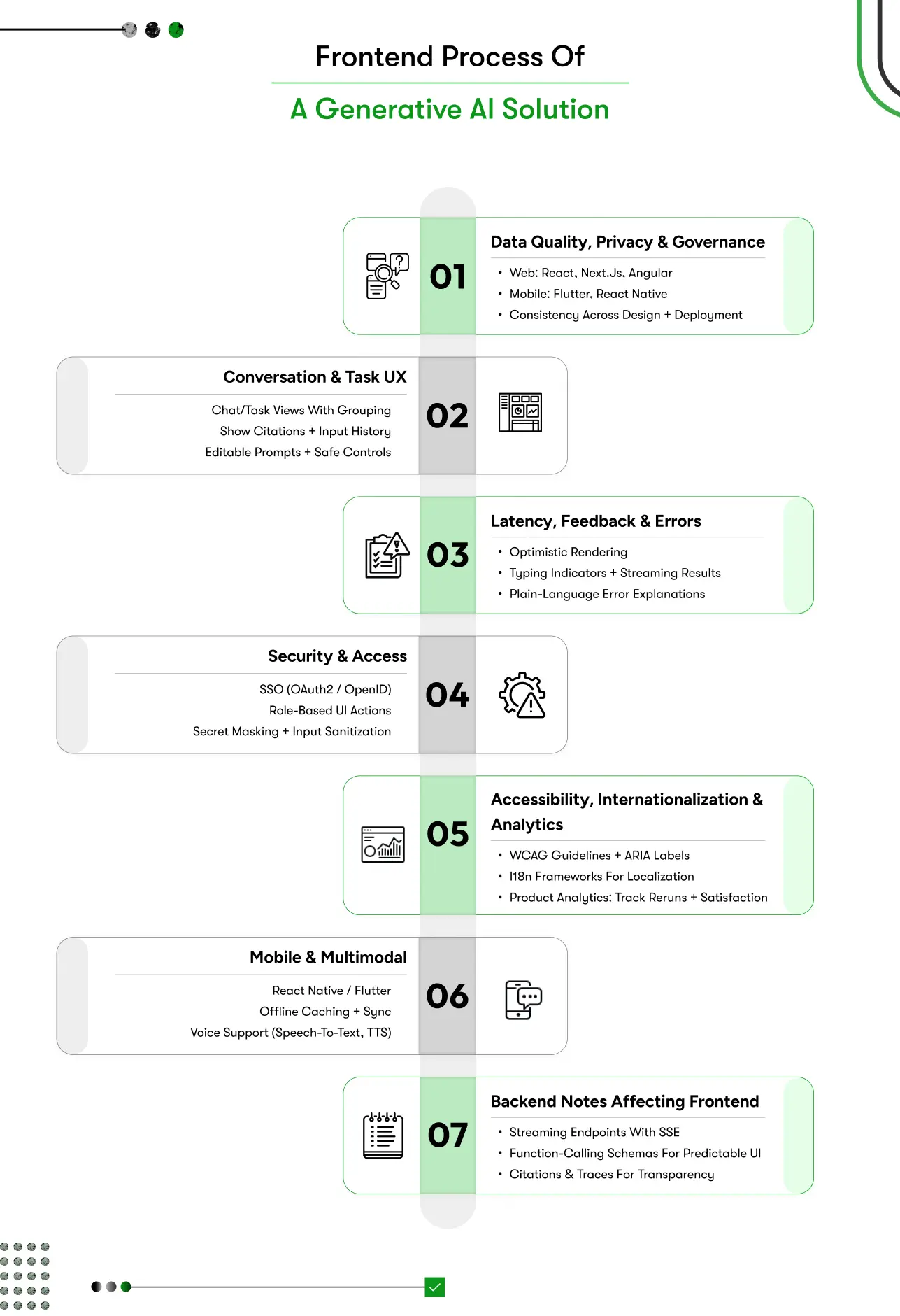
Core web stack and patterns
Teams commonly choose React, Next.js, or Angular for web applications, and Flutter or React Native for mobile. Once selected, the same frameworks carry through both interface design and app deployment, reducing development time and ensuring consistency.
Conversation and task UX
Design chat and task views with message grouping, tool-call markers, and retry controls. Show citations, input history, and editable prompts beside results. Provide temperature, model, and context controls with safe defaults. These patterns help teams develop generative AI solutions that users trust daily.
Latency, feedback, and errors
Use optimistic rendering during model calls, then reconcile on completion. Add typing indicators, partial result streaming, and graceful fallbacks. Explain failures in plain language and suggest fixes. These details matter for generative AI solutions for business where reliability drives adoption.
Security and access
Integrate SSO with OAuth2 or OpenID Connect. Enforce role-based UI states and scoped actions. Mask secrets in forms, sanitize inputs, and throttle requests on the client. Clear boundaries support how to build a generative AI solution with enterprise readiness.
Accessibility, internationalization, and analytics
Follow WCAG guidelines with keyboard-first navigation and ARIA labels. Localize copy with i18n frameworks and date helpers. Track task completion, reruns, and satisfaction with Product Analytics. This data improves your generative AI solution through evidence, not guesses.
Mobile and multimodal
Use React Native or Flutter for mobile companions. Cache recent context offline and sync on reconnect. Add speech-to-text and text-to-speech for voice tasks. Upload images or files with previews and safe client validation.
Quick backend notes that impact the frontend
Expose streaming endpoints with SSE for smooth token flow. Provide function-calling schemas so the UI can render tools predictably. Return traces and citations so the UI can show why results appeared. These contracts make you build a generative AI solution that feels transparent.
API integrations in a Generative AI solution
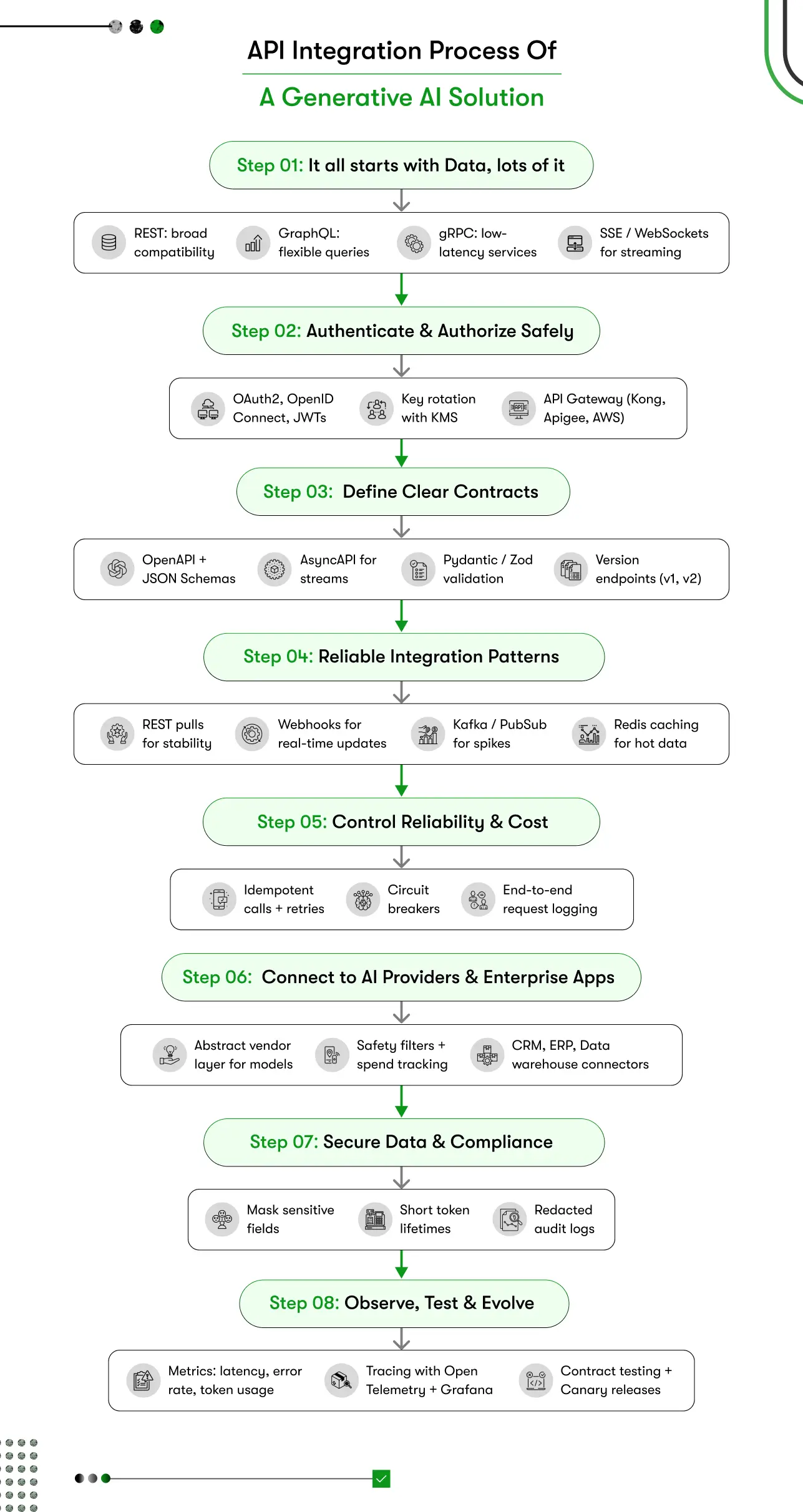
APIs connect your generative AI solution to business systems and data. Good integrations keep information flowing, secure, and observable. Businesses that want to integrate AI into an app rely on strong contracts to prevent surprises and reduce rework during scale and change.
Design the right interface
Choose REST for broad compatibility and caching. Use GraphQL when clients need flexible queries. Pick gRPC for low-latency, typed services inside your network. Stream results with Server-Sent Events or WebSockets when tokens arrive gradually.
Authenticate and authorize safely
Adopt OAuth2 or OpenID Connect for user access. Sign requests with JWTs and rotate keys with KMS. Enforce mTLS for service-to-service traffic. Gate everything through an API gateway like Kong, Apigee, or AWS API Gateway.
Define clear contracts
Publish OpenAPI specs and JSON Schemas for every endpoint. Describe events with AsyncAPI when using streams. Validate payloads with Pydantic or Zod. Version endpoints with explicit v1 and v2 paths to avoid breaking clients.
Pick reliable integration patterns
Pull data with scheduled REST calls for stable systems. Push events with webhooks for real-time updates. Use Kafka, Pub/Sub, or Kinesis when volumes spike. Cache hot reads in Redis to cut repeated calls and cost.
Control reliability and cost
Make calls idempotent with request keys. Add retries with exponential backoff and jitter. Use circuit breakers for flaky vendors. Log request IDs end to end. These patterns help teams develop generative ai solutions that stay dependable.
Connect to AI providers and enterprise apps
Abstract model vendors behind one service layer. This layer selects models, adds safety filters, and tracks spend. Integrate CRMs, ERPs, and data warehouses through connectors. That approach helps you build a generative AI solution that fits existing workflows.
Secure data and compliance
Mask sensitive fields before outbound calls. Minimize scopes and set short token lifetimes. Store audit logs with request bodies redacted. These controls protect generative ai solutions for business operating under strict regulations.
Observe, test, and evolve
Expose metrics for latency, error rates, and token usage. Trace requests with OpenTelemetry and visualize in Grafana. Create contract tests for every integration. Canary new versions behind feature flags. This is how to build a generative AI solution that improves continuously.
Strong API integrations make a generative AI solution more than a standalone tool. They connect models to enterprise data, existing platforms, and customer workflows. With the right techniques and strong AI developers skills, businesses avoid bottlenecks and ensure every output creates measurable value.
In the end, reliable APIs turn AI into an active business partner, powering smooth adoption and long-term success.
App development and deployment for Generative AI solutions
App development transforms backend models and APIs into user-friendly products that employees or customers can actually use. This is the stage where business value becomes visible. A generative AI solution without a well-built app remains hidden in infrastructure and fails to gain adoption.
1) App development technologies
- Frontend frameworks: React, Next js, or Angular are popular for web interfaces. Flutter or React Native are used for cross-platform mobile apps.
- State management: Redux, Zustand, or React Query handle AI responses, caching, and error states.
- Styling/UI kits: TailwindCSS, Material UI, or Ant Design provide professional, consistent interfaces.
- Streaming support: WebSockets or Server-Sent Events display responses token by token for smoother user experiences.
2) Backend and middleware
The backend connects the app with the AI model, APIs, and databases. Node.js, FastAPI, or Django REST Framework are common choices. Middleware manages request validation, authentication, and routing between AI endpoints and client applications.
3) Security and authentication
OAuth2, JWTs, and API keys control access. Role-based access ensures only authorized employees see sensitive outputs. Middleware services like Kong, Apigee, or AWS API Gateway enforce quotas and monitoring.
4) Deployment technologies
- Containerization: Docker packages the entire AI application stack.
- Orchestration: Kubernetes manages scaling, rolling updates, and GPU workloads.
- Cloud platforms: AWS (SageMaker, ECS), GCP (Vertex AI, GKE), or Azure AI provide GPU infrastructure and monitoring.
- CI/CD pipelines: GitHub Actions, GitLab CI, or Jenkins automate testing and deployment to different environments.
5) Deployment techniques
- Canary releases: Roll out to a small percentage of users first.
- Blue-green deployment: Maintain two environments to switch safely without downtime.
- Autoscaling: Use Kubernetes Horizontal Pod Autoscaler or cloud auto-scaling to balance traffic spikes.
- Observability: Monitor latency, errors, and token usage with Prometheus, Grafana, or Datadog.
Building a generative AI solution does not end with models. The real success lies in app development and deployment, where technology meets usability. With the right frameworks, cloud platforms, and deployment techniques, businesses transform prototypes into secure, scalable applications that deliver real-world value every day.
Do you need to build a new team for generative AI app development?
Many business leaders assume adopting a generative AI solution means building an entirely new in-house team of data scientists, AI engineers, backend developers, frontend designers, and DevOps specialists.
While that seems logical, creating such a team from scratch increases costs, slows timelines, and makes coordination difficult. The reality is simpler. You can build a generative AI solution with the right expertise, focus on the ROI of AI apps, and avoid hiring every role permanently.
1. AI and Data Engineering
Developing a model involves preparing data pipelines, cleaning datasets, and fine-tuning frameworks like PyTorch or Hugging Face. Most organizations do not need a permanent research team. A smaller group of skilled engineers can adapt existing models to your business use case, saving time and cost.
2. Backend and API Development
A generative AI solution requires a backend that connects data pipelines, APIs, and infrastructure securely. Hiring an entire backend department is unnecessary. A focused team with experience in scalable architectures, databases, and vector search can deliver the same outcomes without bloating payroll.
3. Frontend and User Experience
Raw AI outputs are rarely usable without a proper interface. A frontend team is essential for building dashboards, chat systems, or mobile apps that make the solution practical for daily use. However, instead of building a large in-house design team, businesses can rely on a smaller group of frontend developers who specialize in usability and speed.
4) Cloud, Security, and DevOps
Cloud specialists provision GPUs, containers, and CI/CD for safe releases. DevOps manages Kubernetes, autoscaling, and monitoring across AWS, Azure, or GCP. Leaders often assume they need an entire AI department. In reality, a focused team or the right partner can provide AI engineering, backend expertise, and DevOps support without inflating costs.
5) Ongoing Operations and Improvement
Owners track quality, cost, and drift with transparent dashboards and alerts. Product analytics reveal where users struggle and where responses miss context. Continuous updates keep generative AI solutions for business aligned with goals.
If hiring and managing many roles feels heavy, you can hire AI developers through an experienced company like Kody Technolab. Our team supplies the complete expertise to deliver your generative AI solution end-to-end.
Conclusion
Business leaders everywhere face a decisive question on how to build a generative AI solution that delivers measurable value. True success depends on setting clear goals, following a structured process, and trusting the right team to deliver.
Kody Technolab is a proven generative AI development company with the expertise to handle end-to-end projects. Our engineers, architects, and product specialists design solutions that meet compliance requirements, strengthen decision-making, and improve customer engagement. Each application is created with scalability, security, and measurable business outcomes in mind.
If your organization is exploring generative AI solutions for business, our team can guide the process from planning to deployment. Partner with Kody Technolab to build applications that reduce costs, improve efficiency, and position your enterprise for lasting growth.

FAQs for Generative AI Solutions
1. How do I know if my business really needs a Generative AI solution?
If your teams spend hours on repetitive tasks, struggle with delayed decisions, or face rising costs, a Generative AI solution may be the right step. Companies that build AI chatbots app as part of their strategy often see inefficiency turn into measurable productivity, keeping them competitive.
2. How to build a generative AI solution without overspending?
Start small with prototypes, validate use cases, and scale gradually. To build a generative AI solution cost-effectively:
- Define measurable goals.
- Prepare high-quality datasets.
- Partner with experts instead of hiring full in-house teams.
3. Do I need to hire a full team for development?
No. You don’t need an entire department of AI engineers, backend developers, and DevOps. Most leaders hire a specialized partner who already has these roles, ensuring faster timelines, lower costs, and access to proven expertise.
4. What are the risks of investing in generative AI solutions for business?
The risks usually come from poor planning or lack of governance. Common risks include:
- Unclear goals and wasted budgets.
- Data security and compliance gaps.
- Low adoption due to poor UX.
- High operating costs if not monitored.
5. How long does it take to develop generative AI solutions?
Timelines depend on complexity. Prototypes may take weeks, enterprise-grade apps months. Key factors include:
- Data readiness.
- Defined KPIs.
- Scope of features.
Starting with an MVP helps shorten timelines and reduce risk.
6. How do I measure ROI from a Generative AI solution?
ROI comes from efficiency, revenue growth, and customer retention. Leaders track:
- Time saved in workflows.
- Reduced operational costs.
- Faster decisions with better accuracy.
- Increased customer satisfaction and engagement.
7. Can generative AI integrate with my existing systems?
Yes. Modern APIs and connectors make it possible to integrate with CRMs, ERPs, and cloud tools. A well-designed generative AI solution works with current systems instead of replacing them, ensuring smooth adoption.
8. Is a Generative AI solution secure and compliant?
Security depends on how you build it. With proper design:
- Data is anonymized or masked.
- Access is role-based.
- Systems follow GDPR, HIPAA, or SOC 2.
Choosing the right partner ensures compliance from day one.

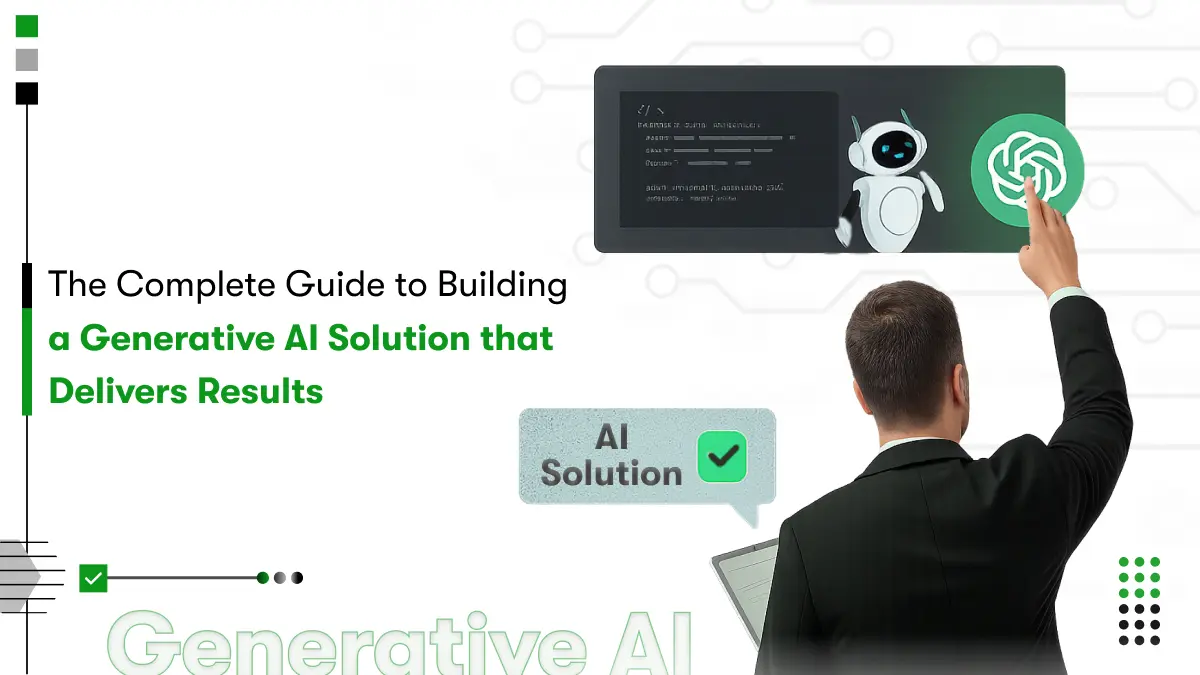
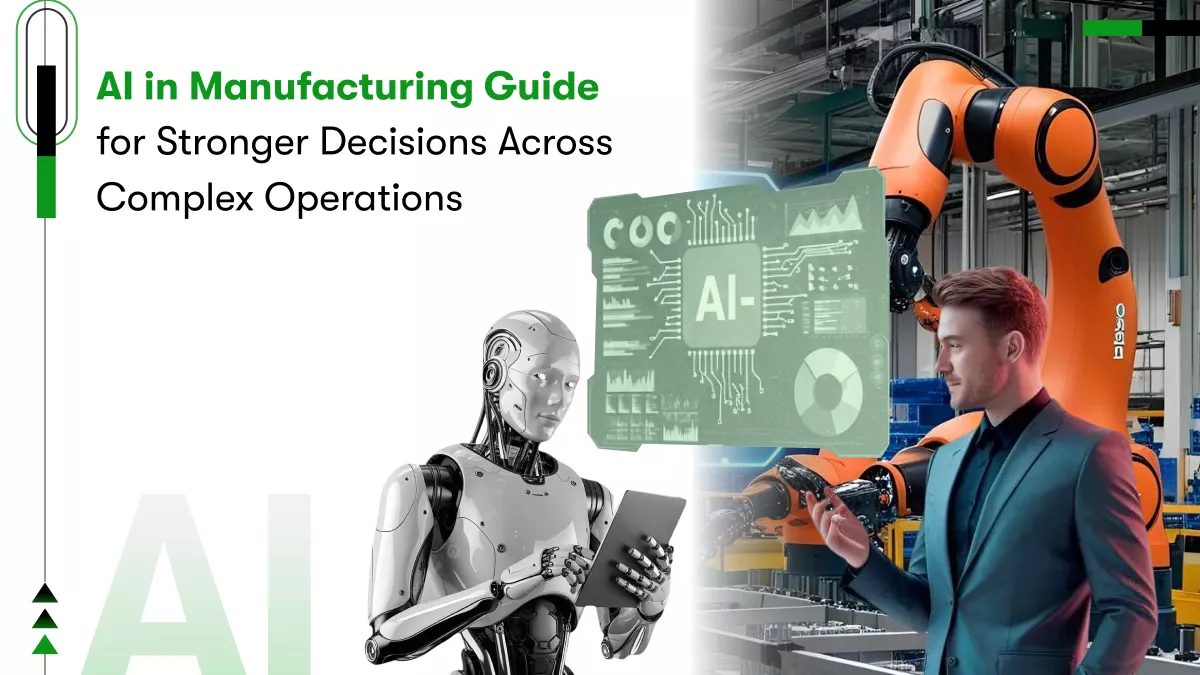

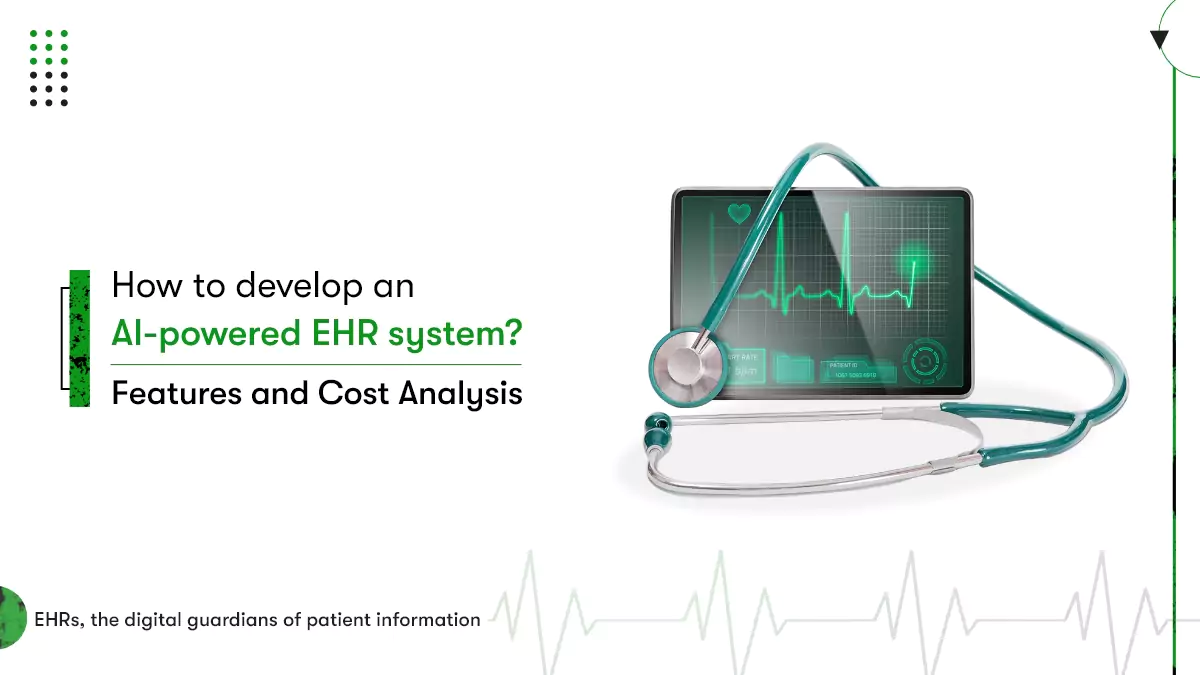








 Contact Information
Contact Information